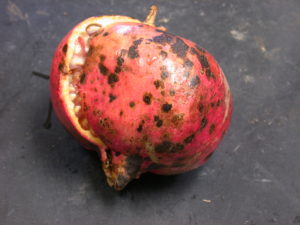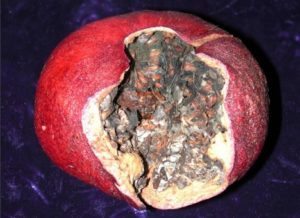 COMMON NAME: Heart Rot of Pomegranate
COMMON NAME: Heart Rot of Pomegranate
SCIENTIFIC NAME: Alternaria alternate and other related species; Aspergillus niger
DISEASE DESCRIPTION
Pomegranate is an ancient cultivated fruit that has gained in popularity in recent times due to the high nutrient value of the edible pomegranate seeds, called arils. Heart rot of pomegranate fruits render the seeds inedible, making it a major disease impacting production worldwide.
 SYMPTOMS
SYMPTOMS
The only exterior signs of disease would be a slight off-color in the peel, and a lighter weight due to internal decay. However, this problem usually is not apparent until fruit sorting after harvest. Once the fruit is cut open, the infection is apparent due to the brown and black rotted seeds that fill the interior cavities.
Similar to Alternaria fruit rot, Aspergillus may grow within the fruit often without external symptoms. However, infected fruit generally are slightly off-color such as a paler red and may show some yellowish to brownish-red discoloration.
BIOLOGY
The most susceptible stage among the flower developmental stages is the anther dehiscence stage (open flowers). A. alternata spores germinate on the stigmata of open flowers and develop into the style. In some fruits, the fungus grows into the tunnel and reaches the lower loculus, where the fungus becomes latent for about 3 to 4 months pending initiation of fruit ripening. Then, the fungus starts growing and invade the arils, causing black rot of the arils. Eventually, the fungus grows from the lower loculus into the upper loculi, causing rot of the entire fruit.
If spores of Alternaria find their way into the aril area, black heart will develop in high levels. Colonization by Aspergillus niger is often associated with insect infestations, such as feeding by hemipterans (leaffooted bug), or other factors that cause fruit injury or cracking
MANAGEMENT METHODS
Because the fruit crown covers the blossom tissues, preharvest sprays are generally ineffective. Good orchard management practices, such as dust control and sanitation (removal of old fruit and dead branches), may reduce the incidence of the disease. Infected, healthy-appearing fruit may be dropped to the ground by gently shaking the tree at the time of harvest. Avoid water stress and overwatering that may result in fruit cracking.
Control insect pests such as leaffooted plant bugs that feed on the fruit, enabling pathogen entry. Remove all fruit before winter to greatly reduce the number of leaffooted plant bugs overwintering in an orchard. Cleaning debris from near the orchard may also help. Cold temperatures near 23°F (5°C) will kill most exposed bugs, while those protected from winter weather survive better. If possible, remove other nearby overwintering hosts such as juniper.
RESOURCE LINKS:
- UC IPM Pest Management Guidelines. University of California’s official guidelines for pest monitoring techniques, pesticides, and nonpesticide alternatives for managing pests in agriculture.
http://ipm.ucanr.edu/PMG/selectnewpest.pomegranate.html
- The American Phytopathological Society. Heart rot of Pomegranate
https://apsjournals.apsnet.org/doi/full/10.1094/PDIS-07-14-0707-RE
- UC Division of Agriculture and Natural Resources. Black Heart and Tree Decline Issues of Pomegranate.
https://ucanr.edu/sites/pomegranates/files/134012.pdf
This factsheet is authored by Cesar Valencia (Masters Entomology)
Factsheet information for the plant health issues represented by the images on the 2019 TPDDL calendar were written by graduate students enrolled in the Department of Plant Pathology & Microbiology PLPA601 Introductory Plant Pathology course in the 2018 Fall semester (course instructor: Dr. David Appel). This exercise provides an opportunity for a high impact learning activity where the students are tasked with producing an informational output directed to the general public and to provide opportunity for the students to write.